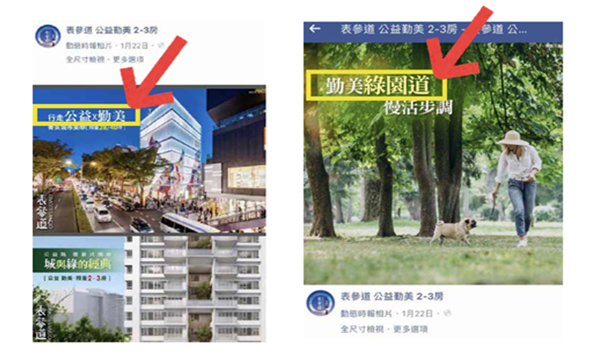Supreme Court Affirmed that Excessive Borrowing of a Registered Mark in Advertising is Not a Fairly Descriptive Use
CMP, founded in 1972, owns a business cluster ranging from residential real estate to retail shopping centers. It is the owner of the following three registered trademarks.
|
TM Number |
TM |
Name |
Class |
Appl. Date |
|
01872485 |
|
Parklane by CMP (Phonetically QingMeiLvYuanDao) |
036 |
2016/11/04 |
|
01872487 |
|
CMP World (Phonetically QingMeiTianDi) |
036 |
2016/11/04 |
|
01872723 |
|
CMP World (Phonetically QingMeiTianDi) |
042 |
2016/11/04 |
Apex group, another realty developer, was found to have widely adopted expressions and slogans associated with “CMP” such as “Parklane by CMP,” “CMP on Gongyi Road” and “CMP x Gongyi” in Apex’s advertisements for a project called Omotesando on Facebook pages and other platforms. CMP sued Apex for infringement of trademarks, while Apex argued that they had used these phrases fairly.

The trial court stood with Apex and rejected CMP’s infringement claims.[1] As the court explained, even though “Parklane by CMP” was a trademark owned by CMP, it also referred to a famous landmark—The Park Lane by CMP, a shopping plaza complex. Apex did indicate its company name on its project advertisements. In the perception of interested consumers, these phrases incorporating the name of CMP would be considered as eye-catchers given that Apex’s project site was in the vicinity of the shopping mall and the nearby commercial area.
CMP appealed the trial decision with the outcome turning against Apex. In reverse, the appellate court found trademark infringement as a result of failed fair use defense.[2]
The core question in the case was whether Apex’s use of the phrase in dispute constituted infringement, and if yes, whether a fair use defense was established. As the court analyzed, these phrases printed on construction project advertisements constituted “application of a trademark to commercial documents relating to goods or services” in the course of trading activities. Hence, Apex engaged in the use of a trademark as legally defined in the Trademark Act. Secondly, Apex’s use of the same trademark fell under the category of realty rental and sale services, the exact same class to which CMP’s registered trademarks were designated. Therefore, Apex were found to have infringed CMP’s trademark rights. Only under a lawful defense would Apex have been free of liabilities.
In its analysis of the fair use defense, the court cited that “trademark right does not restrain a third party if a trademark is employed primarily as a descriptor of, for example, the name, exterior, quality or function of a product or service rather than as an indicator of the source of goods/services”.[3] In the present case, the CMP-related terms appeared repeatedly in Apex’s advertising materials and far more prominently than the Apex terms themselves. Although the phrases “CMP on Gongyi Road” and “CMP X Gongyi” might be deemed to be descriptive in explaining the relative location of the Omotesando project (since Gongyi was the name of a particular road on the map), “CMP” was conceptually irrelevant to Omotesando and “The Parklane by CMP” was not indicative of the quality of Omotesando. The use of terms bearing CMP was not an act necessity of neutral description. “The Parklane by CMP” and other terms containing it were clearly used to promote Apex’s own Omotesando project.
Apex insisted that “The Parklane by CMP” served only to denote the proximity of Omotesando and the shopping mall. However, this argument was similarly untenable. Omotesando was in fact closer to another street market. The distance between Omotesando and The Parklane by CMP was at least 1.1km. Additionally, a running creek separates the two places spatially; thus, general consumers would not consider them to be geographically located in the same commercial area.
After the finding of infringement and failure of fair-use defense, the court awarded damages in favor of CMP.
Apex further filed an appeal to the Supreme Court. However, without the support of new evidence and arguments, the appeal was rejected as a result of the finalized third-instance adjudication.
The Supreme Court’s decision denotes a further clarification of the concept of trademark use and fair use exception; this is echoed by another recent judgment as summarized below.[4]
A Company is the owner of pesticide trademarks “ZhengFeng (with a logo)” and “ZhengFengDong (with a logo).” B Company printed the words ZhengFeng in combination with another product name on it pesticide packaging, claiming that such practice was in line with the pesticide administration measures. Both the courts of first and second instances ruled in favor of B, stating that the use of the words ZhengFeng on its packaging was descriptive in nature, since it presented the brand name and displayed the quality of the product. Hence, the fair use exception was applicable. Following an appeal, the Supreme Court reversed and remanded the case, opining that B Company’s terms on its packaging constituted use of the trademark.
The Supreme Court emphasized that, even though the pesticide measures require that information be disclosed by labeling both the brand name and product’s own name on packaging, whether such practice of combining terms constitutes infringement of a trademark use depends not only on the pesticide measures but also on the Trademark Act, also taking into account the knowledge of the consumer. In this case, the accused packaging bore the term ZhengFengDong accompanied by the symbol ®. Other than ZhengFeng, many other brand names were registered as trademarks. ZhengFeng was an arbitrary term with a higher level of distinctiveness. These were critical factors pending further evaluated to determine whether they constituted use of a trademark. In short, compliance with an administrative measure does not necessarily amount to fair use by harboring an act from trademark infringement.
[1] IPC-110-CivilTMTrial-No.49 (2022.05.04)
[2] IPC-111-CivilTMTrial-No.14 (2022.11.24)
[3] SC-97-TaiwanAppeal-No.364 (2008.02.29)
[4] SC-111-TaiwanAppeal-No.835 (2022.05.25)
Please contact info@tsailee.com for any inquiries.


